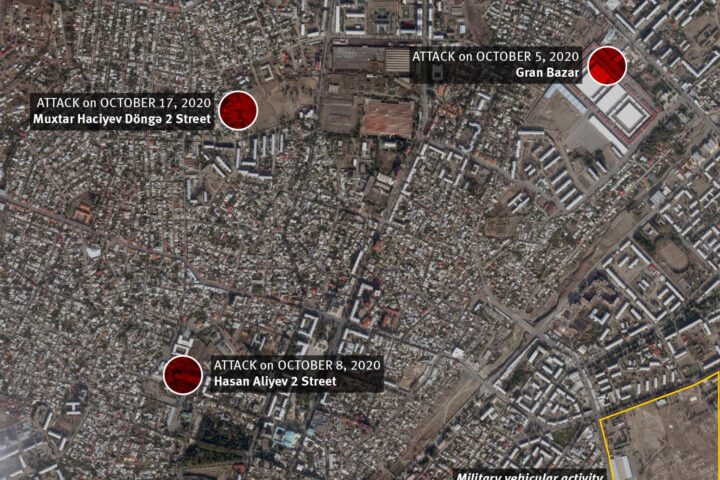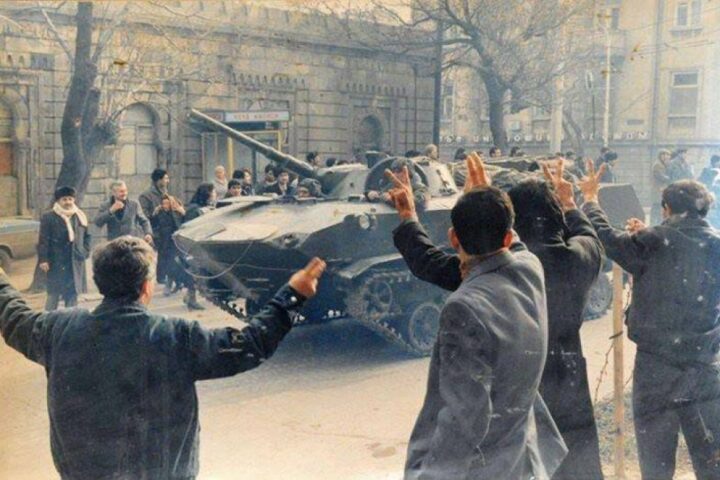Introduction
Relations between two countries worsened after Armenia occupied Azerbaijani territories between the years of 1988 and 1994. Since 1994, the Karabakh conflict remains frozen even after international mediation. This article aims to explore whether Armenia is truly on the winning side, as well as showing Azerbaijan’s major advantage in this conflict. Research and analysis shows that Armenia experienced economic, demographic, and political crises after the conflict, putting the country in an undesirable situation, while ongoing conflict prevents Armenia from solving its economic and demographic problems. Unlike Armenia, Azerbaijan is doing well with the help of its oil reserves, experiencing an oil boom at the end of the twentieth century. This helped to improve country’s economy by decreasing both unemployment and the poverty rate. As Armenia has no such resources, it must rely on expanded trade to improve its economy. Moreover, Turkey and Azerbaijan closed their borders with Armenia a result of the conflict. Closed borders with two of four neighbor countries prevents Armenia from expanding trade and receiving investment, thus harming its economy and leading to demographic problems as more and more people leave the country every year in search of economic opportunity. The continuing occupation of Azerbaijani territories by Armenia puts the latter in a disadvantageous position.
Brief Background
 Azerbaijan President Ilham Aliyev, Russia President Dmitry Medvedev, and Armenia President Serj Sarkisian, November 2, 2008
Azerbaijan President Ilham Aliyev, Russia President Dmitry Medvedev, and Armenia President Serj Sarkisian, November 2, 2008Azerbaijan, as a most powerful and resource-rich country in the South Caucasus region, uses its power and resources to increase its importance in the region and pressure countries like Armenia to abandon offensive politics against Azerbaijan. It is important to note that Armenia occupied more than 16 percent of Azerbaijani territories as a result of the Nagorno Karabakh conflict, displacing approximately 800,000 Azerbaijanis from their territories. Additionally, the United Nations recognizes the territorial integrity of Azerbaijan Republic and has four resolutions that call on withdrawal of Armenian forces from occupied districts of Azerbaijan.[1] However, the Armenian side does not want to comply with the UN resolutions. Poor relations between Azerbaijan and Armenia pressure the latter to change its offensive policy regarding the Nagorno-Karabakh conflict, keeping Armenia away from the region’s important oil projects. Azerbaijan, as an owner of the oil resources in South Caucasus region, does not agree with the participation of Armenia in such projects so long as the region remains occupied. This decreases Armenia’s importance in the region, undermining its relations with the West and with Turkey.
Analysis
After the collapse of the Soviet Union, Armenia gained independence along with countries such as Azerbaijan and Georgia. Armenia needed a strong ally for security, and thus it reinforced relations with the United States using its lobby. Azerbaijan’s former president, Heydar Aliyev, was successful in showing the importance of the Azerbaijani-US cooperation for both countries. He showed his willingness to collaborate with the US government and helped to increase US-Azerbaijani bilateral relations.[2] Heydar Aliyev was successful in showing the significance of Azerbaijan as a reliable strategic partner, changing the political picture in the region as the US interest in Armenia decreased alongside increasing Azerbaijani-US bilateral relations. While the US-Azerbaijani cooperation in the energy sector and in others sectors were increasing, the Armenian-US relations began to weaken.
The good relations with Turkey could return the Western interest to Armenia because Turkey’s geopolitical position helps the country to create a bridge between the West and the South Caucasus countries. But Armenian-Turkish relations worsened due to the Armenian occupation of Azerbaijani territories. Turkish officials expressed a strong reaction to the Armenian offense against Azerbaijan’s territorial integrity, closing the border with Armenia in 1993 to pressure Armenia to withdraw from the occupied lands.[3] We see that the Nagorno-Karabakh conflict destroyed Armenian Turkish relations.
All three South Caucasus countries of Azerbaijan, Georgia and Armenia signed the Tashkent agreement to enter the CIS (Commonwealth of Independent States).[4] Russia used conflicts like Nagorno Karabakh, South Ossetia, and Abkhazia to keep all three countries dependent.[5] Given that Turkish officials supported Azerbaijani side in the Nagorno-Karabakh conflict, Armenia was vulnerable in terms of security because its relations were strained with two of its neighbors. Armenian officials had to guarantee the country’s security, which is why they signed an agreement in 1992 with Russia, allowing the Russian forces to protect the Armenian borders with Turkey. Unlike Armenians, Azerbaijani officials showed their position by refusing to allow the placing Russian military bases in the country.[6] Meanwhile, the Turkish reaction against Armenia broke the attempted bridge between Armenia and the West. While the U.S. was establishing military cooperation with Azerbaijan and Georgia,[7] Russia was placing its forces in Armenia, making it more dependent.
Excepting kinship and close relations between Azerbaijan and Turkey, one of the main sources of Turkish pressure on Armenia was its energy interest in Azerbaijan. In 1993, the Azerbaijani president signed an agreement with Turkey regarding the construction of a pipeline between Baku and Ceyhan. This pipeline was to transport Azerbaijani oil to European markets, giving Turkey the chance to play a key role in the region.[8] Turkey was ready to expend diligent effort to keep the Baku-Ceyhan project alive.[9] This guaranteed the continuing Turkish support for Azerbaijan in Karabakh conflict.
Azerbaijan’s policy not only influenced Turkey, but it also made the US pressure Armenia. The United States, Turkey, and Azerbaijan prepared a proposal for Armenia, entitled “Armenian withdrawal from the occupied territories and recognition of Azerbaijani sovereignty over Nagorno-Karabakh in exchange for the passage of the Baku Ceyhan pipeline through Armenia.”[10] This proposal was mentioned in 1995 by the former Turkish president, Suleyman Demirel, and in 1997 by Heydar Aliyev. The Armenian side rejected the proposal by responding that the “two issues should not be linked.”[11] The president of Armenia argued that “Armenia should not be bypassed as a transit country”.[12] Azerbaijan responded to the Armenian decision by showing support for the Baku-Tibilisi-Ceyhan course, and Azerbaijan, Georgia, and Turkey signed an agreement in 1999.[13] If Armenia withdraws from the occupied areas, the pipeline would flow through Armenian soil. Armenia would benefit from transit fees and develop its weak economy. Participation in the project would also increase the country’s importance in the region. The differing policies of Armenia and Georgia determined their presence in the BTC project. Georgia’s good relations with Azerbaijan and Turkey, Armenia’s poor relations with the same nations created a winner in the case of Georgia and a loser in the case of Armenia in a zero sum game. Poor relations with Turkey and Azerbaijan led Armenia to establish close relations with Russia, making it more dependent.
Armenia’s weak economy not only prevents development of the country, but it also creates demographic problems. According to Forbes’s newest ranking, Armenia has the second worst economy after Madagascar.[14] Such an economy decreases the population of the country because citizens often opt to leave the country in search of better life. This also will put Armenia in a disadvantageous position in the Karabakh conflict. It means that time works in favor of Azerbaijan more than, it does for Armenia. Depopulation of Armenia has increased with the Russian “Compatriots program” since 2009. This program was established to bring Russian speaking people from CIS countries into 24 Russian regions. According to statistics 2,000 Armenian citizens participated in the program in 2010. The majority of Armenian people think that this deepens a demographic problem. It is important to mention that after independence in 1991, 1.1 million Armenians left their motherland to achieve better quality life.[15] According to CIA data for the year of 2011, the Armenian population is 2,967,975.[16] 1.1 million citizens is a tragic loss for the remaining 3 million Armenians. The president of Armenia, Serj Sargisian, sees a solution for decrease emigration in creating better economic opportunities for Armenian people.[17]
Realistically, with the second worst economy in the world and with limited trade and investment opportunities, it is not likely that this plan will be successful. The only solution for Armenia is the liberation of the internationally recognized Azerbaijani lands. Only after that can Armenia benefit from trade with Turkey and Azerbaijan. Armenia can also get a chance to participate in future projects in the region which would be beneficial for its economy and increase its importance in the region.
Unlike Armenia, Azerbaijan experienced fast GDP growth after receiving a tremendous amount of investment to its oil sector. Between 2002 and 2006, per capita GDP growth rate per year increased from 7.3% to 30.6%. The country experienced falling GDP growth between the years of 2006 and 2008 to 15.7 %. However, if we look at GDP growth between the years of 2002 and 2008, we see two times increase.[18] The rate of the poverty declined from 49% to 40% between the years of 2001 and 2004.[19] The year of 2009 sees considerable changes as poverty decreased to 11%,[20] and the inflation rate decreased from 20.8% to 1.5% between the years of 2008 and 2009.[21] We see that oil exports in Azerbaijan help to improve its economy and quality of life for its people.
If Armenia had good relations with Azerbaijan, it would enjoy the benefits of being a transit country for oil exports to the Western markets. This would increase the West’s strategic interest in the country, and Armenia would also benefit from the trade with Turkey. It is important to note that Armenia has borders with the four countries of Georgia, Turkey, Azerbaijan and Iran, but borders with two of these neighbors are closed. This leads Armenia to reinforce relations with Russia and Iran and increases Armenia’s dependence on these countries preventing its integration to the West. In order to get access to the major oil projects in the region and benefit from the trade with all of its neighbors, the Armenian government should change its politics regarding Nagorno-Karabakh.[22] Even the former President of Armenia, Ter-Petrosian, believed that Armenia should come to some agreement about the Nagorno-Karabakh issue because the remaining conflict undermines Armenian prosperity and sovereignty. He told the Armenian people that they must choose between Nagorno-Karabakh and development.[23]
The last meeting held in Kazan with the mediation of Russian president Dmitry Medvedev shows that the two sides still cannot come to agreement. An expert on Caucasus and editor of the book “Black Garden”, Thomas De Waal argued after the meeting that disagreements in the Kazan meeting could bring the negotiations to dangerous point. He said that if the two sides do not agree on the base principles accepted in Madrid Summit, war could become inevitable.[24] The modified Madrid Principles are following:
1. The return of occupied territories surrounding Nagorno-Karabakh to Azerbaijani control.
2. A land corridor linking Armenia to Nagorno-Karabakh through Lachin district
3. An interim status for Nagorno-Karabakh guaranteeing its security and self-governance
4. Final status of Nagorno-Karabakh to be determined by a legally binding referendum
5. The right of return for all internally displaced persons and refugees
War is an undesirable solution for both sides, but it is Armenia that is more vulnerable. If we compare two countries’ military capacity we can see an increasing gap as oil revenues help Azerbaijan to build up its military. The Azerbaijani president has noted many times in media that they will use military force if necessary to reclaim occupied lands.[25]
Conclusion
The Nagorno Karabakh conflict has had unpleasant results for two countries. Azerbaijan has had 16 percent of its territories occupied and 800,000 of its people displaced. On the other side, Armenia still cannot improve its weak economy. As a result, Armenia is the world’s second worst economy, and poor economy itself created demographic problems in the country as more and more people are willing to leave every year. Armenia lost its significance in the region and its relations with West and Turkey has been undermined. Its dependence on Russia is increasing as Armenia allows Russian troops to enter their lands for security reasons. Also, Armenia was bypassed as a transit country in the BTC project because officials refused to withdraw from occupied Azerbaijani territories. All facts show that Armenian officials need to change their policy regarding the Nagorno Karabakth conflict if they want prosperity for their nation. If they do not withdraw from occupied lands, which would be the only possible solution, their economy will get even worse and the demographic crisis will deepen. The increased poverty rate and unemployment will cause internal conflict which will undermine stability in the country. Armenian officials and people need to understand that there are two options: prosperity without Karabakh or poverty with Karabakh.
Notes
http://www.eurasianet.org/node/63157
https://www.cia.gov/library/publications/the-world-factbook/geos/am.html
http://www.iiss.org/publications/strategic-comments/past-issues/volume-17-2011/august/medvedev-momentum-falters-in-nagorno-karabakh/
[no_toc]








